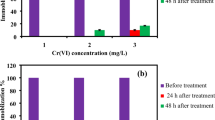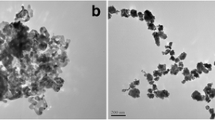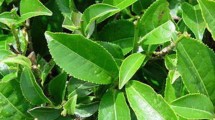Abstract
In this study, aquatic stability and toxic effects of TiO2 and AgTiO2 nanoparticles (NPs) were investigated on Artemia salina nauplii. AgTiO2 was found to be more toxic to nauplii compared to TiO2. The mortality rate in nauplii increased significantly with increasing concentrations and duration of exposure. TiO2 eliminations ranged between 27.8 % and 96.5 % at 50 and 1 mg/L TiO2 exposed to nauplii, respectively. Accumulation and elimination of Ag in AgTiO2 exposed nauplii were similar except at 1 mg/L AgTiO2. When NPs were mixed with water, the hydrodynamic dimensions of NPs significantly increased because of aggregation in saltwater but NP size decreased over time. NPs-exposed nauplii showed changes in eye formation, enlargement of the intestine, malformations in the outer shell and antennae loss were also observed. Since accumulation and toxicity of AgTiO2 NPs was higher than TiO2 alone, inevitably release of AgTiO2 into aqueous environments can cause ecological risks.






Similar content being viewed by others
References
Aitken RJ, Chaudhry MQ, Boxall ABA, Hull M (2006) Manufacture and use of nanomaterials: current status in the UK and global trends. Occup Med Oxford 56:300–306
Altinok I, Capkin E, Boran H (2011) Influence of bioassay volume, water column height, and octanol-water partition coefficient on the toxicity of pesticides to rainbow trout. Bull Environ Contam Toxicol 86:596–600
Arslan Z, Ertas N, Tyson JF, Uden PC, Denoyer ER (2000) Determination of trace elements in marine plankton by inductively coupled plasma mass spectrometry (ICP-MS). Fresenius J Anal Chem 366:273–282
Arulvasu C, Jennifer SM, Prabhu D, Chandhirasekar D (2014) Toxicity effect of silver nanoparticles in brine shrimp Artemia. Sci World J. doi:10.1155/2014/256919
Ates M, Daniels J, Arslan Z, Farah IO (2013) Effects of aqueous suspensions of titanium dioxide nanoparticles on Artemia salina: assessment of nanoparticle aggregation, accumulation, and toxicity. Environ Monit Assess 185:3339–3348
Bai W, Zhang ZY, Tian WJ, He X, Ma YH, Zhao YL, Chai ZF (2010) Toxicity of zinc oxide nanoparticles to zebrafish embryo: a physicochemical study of toxicity mechanism. J Nanopart Res 12:1645–1654
Boxall A, Chaudhry Q, Sinclair C, Jones A, Aitken R, Jefferson B, Watts C (2007) Current and future predicted environmental exposure to engineered nanoparticles. Central Science Laboratory, York
Choi H, Stathatos E, Dionysiou DD (2006) Sol-gel preparation of mesoporous photocatalytic TiO2 films and TiO2/Al2O3 composite membranes for environmental applications. Appl Catal B Environ 63:60–67
Clemente Z, Castro VL, Jonsson CM, Fraceto LF (2014) Minimal levels of ultraviolet light enhance the toxicity of TiO2 nanoparticles to two representative organisms of aquatic systems. J Nanopart Res 16:2559–2575
Daughton CG (2004) Non-regulated water contaminants: emerging research. Environ Impact Assess Rev 24:711–732
Dimkpa CO, McLean JE, Britt DW, Anderson AJ (2013) Antifungal activity of ZnO nanoparticles and their interactive effect with a biocontrol bacterium on growth antagonism of the plant pathogen Fusarium graminearum. Biometals 26:913–924
Esterkin CR, Negro AC, Alfano OM, Cassano AE (2005) Air pollution remediation in a fixed bed photocatalytic reactor coated with TiO2. AIChE J 51:2298–2310
Farre M, Gajda-Schrantz K, Kantiani L, Barcelo D (2009) Ecotoxicity and analysis of nanomaterials in the aquatic environment. Anal Bioanal Chem 393:81–95
Ma R, Levard C, Marinakos SM, Cheng Y, Liu J, Michel FM, Brown GE, Lowry GV (2011) Size-controlled dissolution of organic-coated silver nanoparticles. Environ Sci Technol 46:752–759
Nel A, Xia T, Madler L, Li N (2006) Toxic potential of materials at the nanolevel. Science 311:622–627
Nowack B, Bucheli TD (2007) Occurrence, behavior and effects of nanoparticles in the environment. Environ Pollut 150:5–22
OECD (2004) Test No. 202: Daphnia sp. acute immobilisation test. In: OECD Guidelines for the testing of chemicals, Section 2. OECD Publishing, Paris
Rand GM (1995) Fundamentals of aquatic toxicology: effects, environmental fate and risk assessment. Taylor and Francis, Philadelphia
Service RF (2005) Nanotechnology – calls rise for more research on toxicology of nanomateriais. Science 310:1609
Sorgeloos P (1980) Availability of references Artemia cysts. Mar Ecol Prog Ser 3:363–364
Sorgeloos P, Remiche-Van Der Wielen C, Persoone G (1978) The use of Artemia nauplii for toxicity tests – a critical analysis. Ecotoxicol Environ Saf 2:249–255
Taurozzi JS, Hackley VA, Wiesner MR (2011) Ultrasonic dispersion of nanoparticles for environmental, health and safety assessment – issues and recommendations. Nanotoxicology 5:711–729
Wang LF, Habibul N, He DQ, Li WW, Zhang X, Jiang H, Yu HQ (2015) Copper release from copper nanoparticles in the presence of natural organic matter. Water Res 68:12–23
Xiong DW, Fang T, Yu LP, Sima XF, Zhu WT (2011) Effects of nano-scale TiO2, ZnO and their bulk counterparts on zebrafish: acute toxicity, oxidative stress and oxidative damage. Sci Total Environ 409:1444–1452
Yan J, Lin B, Hu C, Zhang HS, Lin ZQ, Xi ZG (2014) The combined toxicological effects of titanium dioxide nanoparticles and bisphenol A on zebrafish embryos. Nanoscale Res Lett 9:406
Zhao CM, Wang WX (2011) Comparison of acute and chronic toxicity of silver nanoparticles and silver nitrate to Daphnia magna. Environ Toxicol Chem 30:885–892
Zhao Q, Pang XF, Liu LW, Deng B (2007) The biological effect of iron oxide and its hydrate nanoparticles. Solid State Phenom 121–123:735–738
Zhu XS, Chang Y, Chen YS (2010) Toxicity and bioaccumulation of TiO2 nanoparticle aggregates in Daphnia magna. Chemosphere 78:209–215
Author information
Authors and Affiliations
Corresponding author
Rights and permissions
About this article
Cite this article
Ozkan, Y., Altinok, I., Ilhan, H. et al. Determination of TiO2 and AgTiO2 Nanoparticles in Artemia salina: Toxicity, Morphological Changes, Uptake and Depuration. Bull Environ Contam Toxicol 96, 36–42 (2016). https://doi.org/10.1007/s00128-015-1634-1
Received:
Accepted:
Published:
Issue Date:
DOI: https://doi.org/10.1007/s00128-015-1634-1




